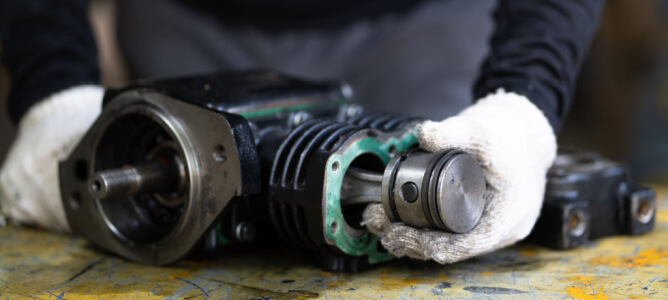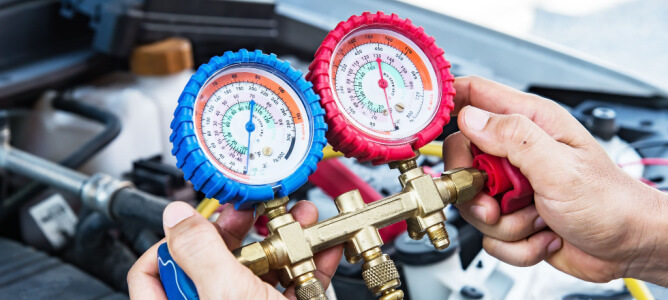
The Complete Guide to Air Compressor Repair
Like any equipment, industrial air compressors can encounter problems that disrupt operations. Deciding whether to repair a damaged air compressor or replace it with a new one isn’t always obvious. Factors like cost, downtime, energy efficiency, and long-term reliability all come into play. This guide breaks down everything you need to know about air compressor repair, from common issues and troubleshooting tips to determining when it’s time to replace your unit.
Air Compressor Repair vs. Replacement
Compressed air is essential for daily operations in several industrial applications. Thus, an air compressor breakdown-induced downtime is detrimental to operators due to lost production, increased costs, and reduced overall business efficiency.
Operators must choose between repairing or replacing the compressor to mitigate these adverse effects. However, several factors determine their choice, including compressor age, energy efficiency, repair history, overall reliability, and ultimately, repair/replacement costs.
Shop NiGen’s portable industrial air compressors now!
Factors to Consider When Deciding Between Air Compressor Repair or Replacement
| Factor | Repair | Replacement |
|---|---|---|
| Age and Operational Hours | Ideal if the compressor is relatively new with few operational hours. | Recommended if the compressor is old and nearing the end of its lifespan. |
| Technological Similarity | Suitable when newer models offer similar capabilities to the existing unit. | Necessary when newer models provide advanced features or substantial performance improvements. |
| Availability of Spare Parts | Viable when spare parts are readily available and repairs can be done quickly. | Better if parts are unavailable or difficult to source. |
| Compressor Reliability | Preferred for a historically reliable compressor with minimal breakdowns. | Advised if the compressor has a history of frequent failures, indicating potential future issues. |
| Energy Efficiency | Repair is practical if energy efficiency improvements are negligible in newer models. | Replacement is better if newer compressors offer significant energy savings to offset costs. |
| Organizational Needs | Repair can suffice if the compressor meets current operational demands. | Replacement is ideal if increased demand requires a larger or more capable unit. |

Common Air Compressor Repairs
Air compressors malfunction or break down when they cannot meet three primary requirements: adequate power, pressure maintenance, and proper airflow control. The prolonged absence of maintenance of the unit can lead to an explosion.
Although it is good practice to contract professionals for complex repairs, operators can also carry out common air compressor repairs. This includes repairing leaks, replacing unloader valves, adjusting airflow, restoring power, repairing electrical issues, and replacing broken intake filters.
Repairing Leaks
To repair leakages in the unit, operators must first unplug every adjoining tool and hose and then start the air compressor booster to allow pressure to build. Next, the operator can apply soapy water solution around each fitting after sufficiently pressurizing the unit. Fittings with leakages will form bubbles, which is indicative of maintenance.
The operator can then depressurize the compressor to fix each leaking fittings with sufficient Teflon tapes. Moreover, the operator must repeat the entire process to confirm the presence or absence of any more leakages.
Replacing the Unloader Valve
Some faults require part replacement to repairs. For instance, a faulty unloader valve can lead to trapped air over the pistons, resulting in breaker trips at startup. Operators can address this issue by inspecting the valve, cleaning it, and, ultimately, replacing it with a new one, especially if the fault persists.
Adjusting Airflow
This air compressor repair significantly depends on adjusting the screws underneath the pressure maintaining valve. The top and bottom screws turn off and on the compressor, respectively. Adjusting the airflow includes turning on and off the compressor and using an extra upper screw for pressure control. Operators can adjust the pressure of the compressor and, correspondingly, the airflow by tightening or loosening the upper screw to get the ideal pressure.
Restoring Power
Several considerations for restoring power to the compressor unit include fully plugging the compressor, ensuring the switch is on, resetting the system, the condition of the power source, and the presence of extensions. In addition, the operator must take the unit to technicians for professional repairs if all is in order.
Read now: How Does a Rotary Screw Air Compressor Work?
Repairing Electrical Issues
Air compressors can persistently blow fuses and breakers. To mitigate this issue, operators must replace the use of extensions with direct connections to the power source. Additionally, loose capacitor wires and other forms of wear in old motors in the unit can blow fuses and breakers. Therefore, operators must identify old motor-induced breakdowns and replace them when required.
Replacing Broken Intake Filters
Like the unloading valve, operators must replace broken intake filters due to their importance to the entire unit. Since intake filters stick out from the compressor, they are susceptible to damage. Operators must find filters with similar thread and portal sizes and the diameter to replace damaged ones in the system.
Need Air Compressor Repairs or Replacement? We Can Help.
NiGen is dedicated to offering clients air compressor repair and replacement services that meet the highest industry standards. Whether you want to repair or replace your industrial portable air compressor, we provide industry-leading procurement and maintenance services on several compressor types and brands.
Contact us today for all your air compressor needs.
